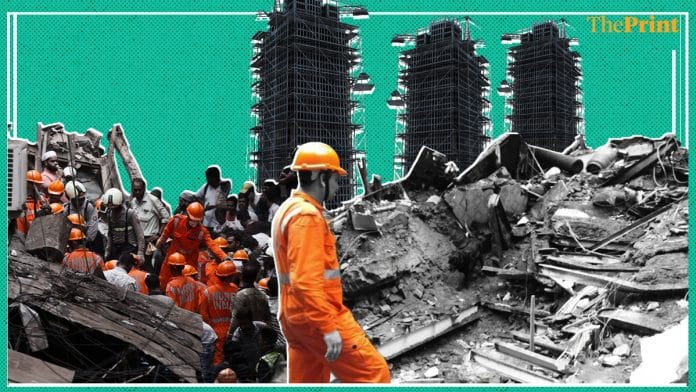Mumbai, the financial capital of India, is facing its second serious infrastructure disaster in a month. The collapse of a building in Dongri area comes weeks after a wall had collapsed in Malad.
In Delhi, it took nearly five years to build and inaugurate a 2.7-km-long flyover. Chennai is facing a severe water crisis this summer, with taps running dry.
ThePrint asks: Mumbai building collapse: Should India save its metropolises before dreaming of smart cities?
Need one umbrella authority, which should be responsible for infrastructure development
 Sulakshana Mahajan
Sulakshana Mahajan
Former urban planning consultant, Mumbai Transformation Support Unit
Before thinking of smart cities, we must consider the infrastructural challenges faced by the big cities and how they have ended up in such a sorry state.
Each big city, be it Mumbai or Chennai, has its own set of challenges, from lack of land to lack of water. The infrastructural challenge needs to be placed in the context of each city’s geography and history.
Mega cities of the West, like New York or London, have their own independent local governance system to deal with the unique challenges they face. However, in India, the mandate of civic authorities is often overlooked by the state governments.
As a result, there is no clarity on who is in charge of the city’s developing infrastructure.
In Mumbai, for example, the Mumbai Metropolitan Region Development Authority (MMRDA) was initially not involved in building infrastructure for the city. But now, along with local municipal authorities, it is responsible for developing the city’s infrastructure. This has made governance chaotic and confusing.
There should be a single umbrella authority responsible for infrastructure development. This will lead to better coordination, faster decision-making and greater accountability.
Several buildings in Greater Mumbai constructed without municipal nod & with substandard material
 V. Ramani
V. Ramani
Former additional municipal commissioner, Mumbai Municipal Corporation
Lax building regulations and corruption are the major reasons for the frequent collapse of buildings across cities.
In the areas in and around Greater Mumbai, a significant number of buildings have been built without municipal permissions, with substandard material and without any consideration to the required building codes. They are disasters waiting to happen.
As far as the old part of Mumbai city is concerned, it is a matter of public need vs private greed.
The state has a duty to ensure that people’s ‘roti, kapda, makaan’ needs are met. The Bombay Rents, Hotel and Lodging House Rates Control Act, 1947 had created its fair share of problems. These have not been solved to date by the Maharashtra Rent Control Act, which replaced it in 1999.
Landlords have found it convenient to let buildings rot because many provisions of the Act are frankly unimplementable. At least 70 per cent of the tenants have to agree to alterations and repair of the flats and move out for at least 18 months. Few tenants would agree to this. Even if there is a provision for a transit housing, tenants may still be unwilling to move out because of the costs and inconvenience involved.
It is, therefore, a Catch-22 situation and calls for a herculean effort to look for a solution. The state will have to work with the municipal corporation, tenants, landlords and the housing industry to first identify the buildings that urgently need repair and then provide for the necessary public and private financial resources to do so.
Also read: 10 fastest-growing global cities in India: Economic boom or poor focus on quality of life?
Governance in Indian cities is stuck between state that controls everything and Centre that wants to
 Pavan Srinath
Pavan Srinath
Public policy researcher, Takshashila Institution
Municipalities in India are little more than subcontractors today. They are not even local level administrators most of the time. Between a state government, which still controls everything, and a Union government, which wants to directly intervene in our urban development, we don’t have any local leaders who are empowered and can be held accountable.
Cities are engines of both economic growth and growth of government revenue. But they see very little of it. Put together, cities earn less than 1 per cent of India’s GDP by way of taxes and charges. How will these cities manage crumbling infrastructure? How will they become smart?
About thirty years ago, India’s Constitution was finally amended to decentralise power down to the gram panchayat level. Municipalities in the cities received some notional devolution of power, almost as a by-product. But they cannot even decide their own property tax rates, and most don’t even control their own water supply, fire services, transport or traffic police.
State and Union governments can devise many policy- and mission-based band-aids to fix old infrastructure, or build pockets of digitally connected neighbourhoods. But our cities will never be able to address their own challenges until they get governments and political leaders who have the power and the accountability to do so.
Also read: Mumbai building collapse has media searching in the rubble for clues to tragedy
We need a new perspective: focus on rebuilding entire area instead of one fallen structure
 Anjali Karol Mohan
Anjali Karol Mohan
Urban and regional planner
There needs to be a change in the way we approach the issue of crumbling infrastructure. Cities are not just inorganic structures; they are spaces that have evolved over centuries. The building in Mumbai’s Dongri, too, was 100 years old, located in a neighbourhood with extremely narrow streets. Therefore, we need to look at the age of the neighbourhoods as well as the spaces that surround them.
The perspective needs to change from a reactionary one, where we just address each individual collapse of infrastructure, to one where we look at a comprehensive refurbishment of the entire area. This assumes greater significance due to climate change and unprecedented levels of rain in Mumbai this monsoon. We need to be prepared and start proactively looking at renovating the whole city.
The issue of very poor public administration and governance is also one that needs to be addressed. The problem lies in determining who is responsible and accountable in the event of such collapses. Even when the accountability has been fixed, there are no consequences. In cities like Bengaluru, this has resulted in indiscriminate violation and sheer negligence, brought about due to a desire to monetise every available land, with haphazard quality of construction. The system needs an overhaul to fix responsibility and accountability. Raising awareness among citizens too needs to be encouraged so as to make them proactively care about violations.
By Fatima Khan and Shauryavardhan Sharma.







In the greatest cities of the world – the ones with rich heritage – urban planning implies conservation and regeneration. Both go hand in hand. In 1970s, Mumbai – my birthplace – was the envy of the Middle-East. Saw a Sheikh for the first time in Mumbai. They were regulars then. Bandar, Juhu, Khar were full of beautiful bungalows, many of which are today uncouth, tall structures. Were they NOT worth saving with tight regulation? Marine Drive’s art deco architecture stood out. Is this extraordinary landscape NOT worthy of the heritage tag? But while other great cities kept transforming themselves (The dilapidated East End in London, post 2012 Olympics; Berlin, post unification etc.), Mumbai kept degenerating. Imagine when the biggest slum in a city becomes its star attraction!! That’s the day, politicians should stop dreaming of smart cities and think of regeneration.
Biggest slum in the world becomes its star tourist attraction.
The next phase of urbanisation needs to start. India still has too large a proportion of its population living in rural areas. Given our per capita and high cost of urban land – except when it is encroached upon, when it is zero – chaotic urbanisation, led by slums is inevitable. Smart cities, as promised, lie at least fifty, possibly a hundred, years in the future. 2. Urban India needs a lot more money and public investment. Too much of Bombay’s resources – where Delhi scores over us – pay to keep the rest of the state afloat. That is impeding the emergence of world class cities. 3. There are problems with unauthorised construction, sometimes of poor quality. However, the building crashes like the one at Dongri have a different cause. These are old ceased buildings, most constructed before 1940, which are being kept propped up – sometimes literally – beyond their useful life, courtesy the antiquated rent control act.